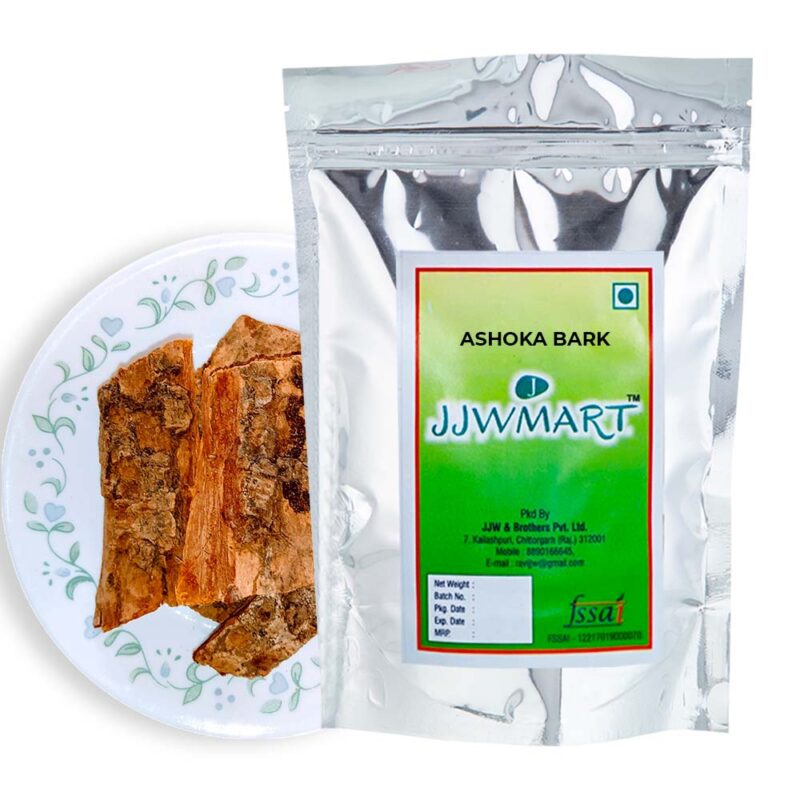Ayurvedic products and herbs
Health Benefits of Ashoka Tree
Struggling with painful periods, heavy menstrual bleeding, or joint discomfort? Ashoka could be your answer! Find out how this ancient tree can help balance your doshas and improve your overall well-being. Read on for helpful tips and tricks to incorporate Ashoka into your daily routine. Explore 6 health benefits of Ashoka tree.
One of the oldest and most revered trees in all of India is the Ashoka, sometimes referred to as the Ashoka briksh. Ashoka, especially its leaves and bark, has several therapeutic uses.
Ashoka aids in the treatment of a variety of menstruation issues in women, including painful, heavy, and irregular periods. To relieve cramps and soreness in the abdomen, consume it as a powder or churna after eating. Because Ashoka bark has blood-purifying properties, consuming its juice or kwath can also support healthy skin.
Ayurveda states that Ashoka’s Kasaya (astringent) quality helps to reduce internal bleeding, particularly in pile cases. Because of its Ropan (healing) quality, it is also helpful in reducing pain and hastening the healing of wounds. Eliminating greasy and lifeless skin can be achieved by applying Ashoka bark juice or kwath to the skin.
Contents
Ashoka Tree Nutritional Value
| Part of the tree | Nutritional Component | Amount |
| Leaf | Alkaloid | 0.064 g |
| Flavonoid | 0.005 g | |
| Saponin | 0.597 g | |
| Flower | Alkaloid | 0.032 g |
| Flavonoid | 0.004 g | |
| Saponin | 0.115 g |
Health Benefits of Ashoka Tree
1) Ashoka tree benefits in painful periods
Experiencing pain or cramps during or before menstruation is known as dysmenorrhea. Ayurveda refers to this condition as Kasht-aartava. According to Ayurveda, the menstrual cycle, or Aartava, is regulated by the Vata dosha. Therefore, maintaining balanced Vata is crucial for managing dysmenorrhea in women. Ashoka is well-known for its ability to balance Vata, offering relief from dysmenorrhea by managing aggravated Vata and reducing abdominal pain and cramps during menstruation.
Useful Tips:
- Bring the bark of the Ashoka tree to a boil in water until the volume of water is reduced to one-fourth of its initial amount.
- Strain the liquid and store the Ashoka kwath (decoction) in a bottle.
- Consume 8-10 teaspoons of Ashoka kwath.
- Dilute with an equal quantity of water and drink the decoction after lunch and dinner to alleviate menstrual pain.
2) Ashoka tree for heavy menstrual bleeding
Menorrhagia, characterized by heavy menstrual bleeding or Raktapradar in Ayurveda, refers to an excessive discharge of menstrual blood. This condition is often linked to an aggravated Pitta dosha. Ashoka plays a pivotal role in balancing an aggravated Pitta and effectively managing heavy menstrual bleeding or menorrhagia. Its cooling (Sita) properties are particularly beneficial in soothing and regulating menstrual flow.
Helpful Tips:
- Boil the bark of the Ashoka tree in water until the volume reduces to one-fourth of its original quantity.
- Strain the liquid and store the Ashoka kwath (decoction) in a bottle.
- Consume 8-10 teaspoons of the Ashoka kwath.
- Dilute the decoction with an equal amount of water and drink it after lunch and dinner to control heavy.
3) Ashoka tree may help with Piles
Hemorrhoids, known as Arsh in Ayurveda, result from an unhealthy diet and a sedentary lifestyle, causing an imbalance in all three doshas, particularly Vata. An aggravated Vata leads to weakened digestive fire, resulting in constipation and subsequent swelling of veins in the rectum, forming piles. Ashoka provides relief by balancing Vata and reducing swelling in pile masses. Additionally, its cooling properties (Sita) alleviate burning sensations and discomfort associated with hemorrhoids, providing a soothing effect.
Helpful Tips:
- Take 1/4-1/2 teaspoon of Ashoka powder.
- Mix it with honey or water.
- Consume it after meals for optimal results.
4) Ashoka tree may help with Leucorrhea
Leucorrhea refers to a thick, whitish discharge from the female genitals, often caused by an imbalance of Kapha dosha according to Ayurveda. Ashoka demonstrates positive effects in treating leucorrhea due to its Kashaya (astringent) property, which helps in controlling aggravated Kapha and alleviating the symptoms of leucorrhea.
Helpful Tips:
- Boil the bark of the Ashoka tree in water until its volume decreases to one-fourth of the original amount.
- Strain the liquid and store the Ashoka kwath (decoction) in a bottle.
- Consume 8-10 teaspoons of the Ashoka kwath.
- Dilute with an equal quantity of water and drink it preferably after lunch and dinner to manage leucorrhea.
5) Accelerated wound recovery
Ashoka aids in the speedy recovery of wounds by reducing pain and swelling in the affected area. Its Ropan (healing) property also assists in restoring the original skin texture.
Helpful Tips:
- Soak the bark of the Ashoka tree in water overnight.
- The next day, create a paste using honey.
- Apply this paste on the affected area for expedited healing.
6) Alleviating joint discomfort
According to Ayurveda, bones and joints are the primary site of Vata dosha in the body. Imbalances in Vata dosha can result in joint pain. Ashoka possesses Vata-balancing properties, and applying a paste made from its bark can provide relief from joint discomfort. These were the top 6 health benefits of ashoka tree.
Helpful Tips:
- Crush Ashoka bark with water to create a paste.
- Apply this paste to the affected areas to alleviate joint pain.
Buy Ashoka Bark Online: Buy Now
Conclusion:
The Ashoka tree offers a wealth of health benefits, particularly for women’s health and wound healing. Its properties help with painful periods, heavy bleeding, hemorrhoids, and joint discomfort, making it a valuable natural remedy.


